Influence of Defects-Induced Stresses on Birefringence in SrTiO3 Single Crystals
Abstract
1. Introduction
2. Materials and Methods
3. Results
3.1. Birefringence and Optical Indicatrix Orientations in SrTiO3 Single Crystals
3.2. Birefringence and Optical Indicatrix Orientations in a SrTiO3 24° Bicrystal
4. Discussion
5. Conclusions
Author Contributions
Funding
Data Availability Statement
Acknowledgments
Conflicts of Interest
References
- Müller, K.A.; Berlinger, W. Static Critical Exponents at Structural Phase Transitions. Phys. Rev. Lett. 1971, 26, 13–16. [Google Scholar] [CrossRef]
- Courtens, E. Birefringence of SrTiO3 Produced by the 105 °K Structural Phase Transition. Phys. Review Lett. 1972, 29, 1380. [Google Scholar] [CrossRef]
- Geday, M.; Glazer, A.M. Birefringence of SrTiO3 at the ferroelastic phase transition. J. Physics: Condens. Matter 2004, 16, 3303–3310. [Google Scholar] [CrossRef]
- Bussmann-Holder, A.; Köhler, J.; Kremer, R.K.; Law, J.M. Relation between structural instabilities in EuTiO3 and SrTiO3. Phys. Rev. B 2011, 83, 212102. [Google Scholar] [CrossRef]
- Roleder, K.; Bussmann-Holder, A.; Górny, M.; Szot, K.; Glazer, A. Precursor dynamics to the structural instability in SrTiO3. Phase Transit. 2012, 85, 939–948. [Google Scholar] [CrossRef]
- Rodenbücher, C.; Bittkau, K.; Bihlmayer, G.; Wrana, D.; Gensch, T.; Korte, C.; Krok, F.; Szot, K. Mapping the conducting channels formed along extended defects in SrTiO3 by means of scanning near-field optical microscopy. Sci. Rep. 2020, 10, 17763. [Google Scholar] [CrossRef]
- Rodenbücher, C.; Wrana, D.; Gensch, T.; Krok, F.; Korte, C.; Szot, K. The Electronic Properties of Extended Defects in SrTiO3—A Case Study of a Real Bicrystal Boundary. Crystals 2020, 10, 665. [Google Scholar] [CrossRef]
- Zubko, P.; Catalan, G.; Buckley, A.; Welche PR, L.; Scott, J.F. Strain-gradient-induced polarization in SrTiO3 single crystals. Phys. Rev. Lett. 2007, 99, 167601. [Google Scholar] [CrossRef]
- Wang, R.; Zhu, Y.; Shapiro, S. Structural defects and the origin of the second length scale in SrTiO3. Phys. Rev. Lett. 1998, 80, 2370. [Google Scholar] [CrossRef]
- Szot, K.; Speier, W.; Bihlmayer, G.; Waser, R. Switching the electrical resistance of individual dislocations in single-crystalline SrTiO3. Nat. Mater. 2006, 5, 312–320. [Google Scholar] [CrossRef]
- Yamamoto, T.; Oba, F.; Ikuhara, Y.; Sakuma, T. Current-Voltage Characteristics Across Small Angle Symmetric Tilt Boundaries in Nb-Doped SrTiO3 Bicrystals. Mater. Trans. 2002, 43, 1537–1541. [Google Scholar] [CrossRef]
- Szot, K.; Bihlmayer, G.; Speier, W. Nature of the Resistive Switching Phenomena in TiO2 and SrTiO3: Origin of the Reversible Insulator–Metal Transition, in Solid State Physics; Elsevier: Amsterdam, The Netherlands, 2014; pp. 353–559. [Google Scholar]
- Wrana, D.; Rodenbücher, C.; Bełza, W.; Szot, K.; Krok, F. In situ study of redox processes on the surface of SrTiO3 single crystals. Appl. Surf. Sci. 2018, 432, 46–52. [Google Scholar] [CrossRef]
- Waser, R.; Dittmann, R.; Staikov, G.; Szot, K. Redox-based resistive switching memories–nanoionic mechanisms, prospects, and challenges. Adv. Mater. 2009, 21, 2632–2663. [Google Scholar] [CrossRef]
- Marrocchelli, D.; Sun, L.; Yildiz, B. Dislocations in SrTiO3: Easy To Reduce but Not so Fast for Oxygen Transport. J. Am. Chem. Soc. 2015, 137, 4735–4748. [Google Scholar] [CrossRef]
- Szot, K.; Rodenbücher, C.; Bihlmayer, G.; Speier, W.; Ishikawa, R.; Shibata, N.; Ikuhara, Y. Influence of Dislocations in Transition Metal Oxides on Selected Physical and Chemical Properties. Crystals 2018, 8, 241. [Google Scholar] [CrossRef]
- Spinelli, A.; Torija, M.A.; Liu, C.; Jan, C.; Leighton, C. Electronic transport in doped SrTiO3: Conduction mechanisms and potential applications. Phys. Rev. B 2010, 81, 155110. [Google Scholar] [CrossRef]
- Yoshimura, J.; Sakamoto, T.; Usui, S.; Kimura, S. X-ray perfection study of Verneuil-grown SrTiO3 crystals. J. Cryst. Growth 1998, 191, 483–491. [Google Scholar] [CrossRef]
- Rodenbücher, C.; Luysberg, M.; Schwedt, A.; Havel, V.; Gunkel, F.; Mayer, J.; Waser, R. Homogeneity and variation of donor doping in Verneuil-grown SrTiO3:Nb single crystals. Sci. Rep. 2016, 6, 32250. [Google Scholar] [CrossRef]
- Rodenbücher, C.; Bihlmayer, G.; Speier, W.; Kubacki, J.; Wojtyniak, M.; Rogala, M.; Wrana, D.; Krok, F.; Szot, K. Local surface conductivity of transition metal oxides mapped with true atomic resolution. Nanoscale 2018, 10, 11498–11505. [Google Scholar] [CrossRef]
- Geday, M.A.; Kaminsky, W.; Lewis, J.G.; Glazer, A.M. Images of absolute retardance L. Deltan, using the rotating polariser method. J. Microsc. 2000, 198, 1–9. [Google Scholar] [CrossRef]
- Glazer, A.M.; Lewis, J.G.; Kaminsky, W. An automatic optical imaging system for birefringent media. Proc. R. Soc. A Math. Phys. Eng. Sci. 1996, 452, 2751–2765. [Google Scholar] [CrossRef]
- Masuda, K.; Le Van, L.; Shimada, T.; Kitamura, T. Topological ferroelectric nanostructures induced by mechanical strain in strontium titanate. Phys. Chem. Chem. Phys. 2019, 21, 22420–22428. [Google Scholar] [CrossRef] [PubMed]
- Masuda, K.; Van Lich, L.; Shimada, T.; Kitamura, T. Periodically-arrayed ferroelectric nanostructures induced by dislocation structures in strontium titanate. Phys. Chem. Chem. Phys. 2019, 21, 22756–22762. [Google Scholar] [CrossRef] [PubMed]
- McDaniel, E.B.; Hsu, J.W.P. Direct imaging of submicron-scale defect-induced birefringence in SrTiO3 bicrystals. J. Appl. Phys. 1998, 84, 189–193. [Google Scholar] [CrossRef]
- Koyama, Y.; Moriyasu, T.; Okamura, E.; Yamada, Y.; Tanaka, K.; Kohmoto, T. Doping-induced ferroelectric phase transition in strontium titanate: Observation of birefringence and coherent phonons under ultraviolet illumination. Phys. Rev. B 2010, 81, 024104. [Google Scholar] [CrossRef]
- Aizu, K. Determination of the State Parameters and Formulation of Spontaneous Strain for Ferroelastics. J. Phys. Soc. Jpn. 1970, 28, 706–716. [Google Scholar] [CrossRef]
- Okai, B.; Yoshimoto, J. Pressure dependence of the structural phase transition temperature in SrTiO3 and KMnF3. J. Phys. Soc. Jpn. 1975, 39, 162–165. [Google Scholar] [CrossRef]
- Kurt, O.; Le, T.; Sahu, S.K.; Randall, C.A.; Ren, Y. Assessment of Strain Relaxation and Oxygen Vacancy Migration Near Grain Boundary in SrTiO3 Bicrystals by Second Harmonic Generation. J. Phys. Chem. C 2020, 124, 11892–11901. [Google Scholar] [CrossRef]
- Hünnefeld, H.; Niemöller, T.; Schneider, J.R.; Rütt, U.; Rodewald, S.; Fleig, J.; Shirane, G. Influence of defects on the critical behavior at the 105 K structural phase transition of SrTiO3: On the origin of the two length scale critical fluctuations. Phys. Rev. B 2002, 66, 014113. [Google Scholar] [CrossRef]
- Rütt, U.; Diederichs, A.; Schneider, J.R.; Shirane, G. Depth dependence of strain, mosaicity and sharp component in the critical scattering of SrTiO3. Europhys. Lett. 1997, 39, 395. [Google Scholar] [CrossRef]
- Armstrong, M.D.; Lan, K.-W.; Guo, Y.; Perry, N.H. Dislocation-Mediated Conductivity in Oxides: Progress, Challenges, and Opportunities. ACS Nano 2021, 15, 9211–9221. [Google Scholar] [CrossRef] [PubMed]
- Gao, P.; Yang, S.; Ishikawa, R.; Li, N.; Feng, B.; Kumamoto, A.; Shibata, N.; Yu, P.; Ikuhara, Y. Atomic-scale measurement of flexoelectric polarization at SrTiO3 dislocations. Phys. Rev. Lett. 2018, 120, 267601. [Google Scholar] [CrossRef] [PubMed]
- Kondo, S.; Mitsuma, T.; Shibata, N.; Ikuhara, Y. Direct observation of individual dislocation interaction processes with grain boundaries. Sci. Adv. 2016, 2, e1501926. [Google Scholar] [CrossRef] [PubMed]
- Metlenko, V.; Ramadan, A.H.; Gunkel, F.; Du, H.; Schraknepper, H.; Hoffmann-Eifert, S.; Dittmann, R.; Waser, R.; De Souza, R.A. Do dislocations act as atomic autobahns for oxygen in the perovskite oxide SrTiO3? Nanoscale 2014, 6, 12864–12876. [Google Scholar] [CrossRef]
- Okafor, C.; Ding, K.; Zhou, X.; Durst, K.; Rödel, J.; Fang, X. Mechanical tailoring of dislocation densities in SrTiO3 at room temperature. J. Am. Ceram. Soc. 2022, 105, 2399–2402. [Google Scholar] [CrossRef]
- Porz, L.; Frömling, T.; Nakamura, A.; Li, N.; Maruyama, R.; Matsunaga, K.; Gao, P.; Simons, H.; Dietz, C.; Rohnke, M.; et al. Conceptual Framework for Dislocation-Modified Conductivity in Oxide Ceramics Deconvoluting Mesoscopic Structure, Core, and Space Charge Exemplified for SrTiO3. ACS Nano 2020, 15, 9355–9367. [Google Scholar] [CrossRef]
- Schraknepper, H.; Weirich, T.E.; De Souza, R.A. The blocking effect of surface dislocations on oxygen tracer diffusion in SrTiO3. Phys. Chem. Chem. Phys. 2018, 20, 15455–15463. [Google Scholar] [CrossRef]
- Waldow, S.P.; De Souza, R.A. Computational Study of Oxygen Diffusion along a[100] Dislocations in the Perovskite Oxide SrTiO3. ACS Appl. Mater. Interfaces 2016, 8, 12246–12256. [Google Scholar] [CrossRef]
- Zhong, W.; Vanderbilt, D. Competing Structural Instabilities in Cubic Perovskites. Phys. Rev. Lett. 1995, 74, 2587–2590. [Google Scholar] [CrossRef]
- Du, H.; Jia, C.-L.; Houben, L.; Metlenko, V.; De Souza, R.A.; Waser, R.; Mayer, J. Atomic structure and chemistry of dislocation cores at low-angle tilt grain boundary in SrTiO3 bicrystals. Acta Mater. 2015, 89, 344–351. [Google Scholar] [CrossRef]
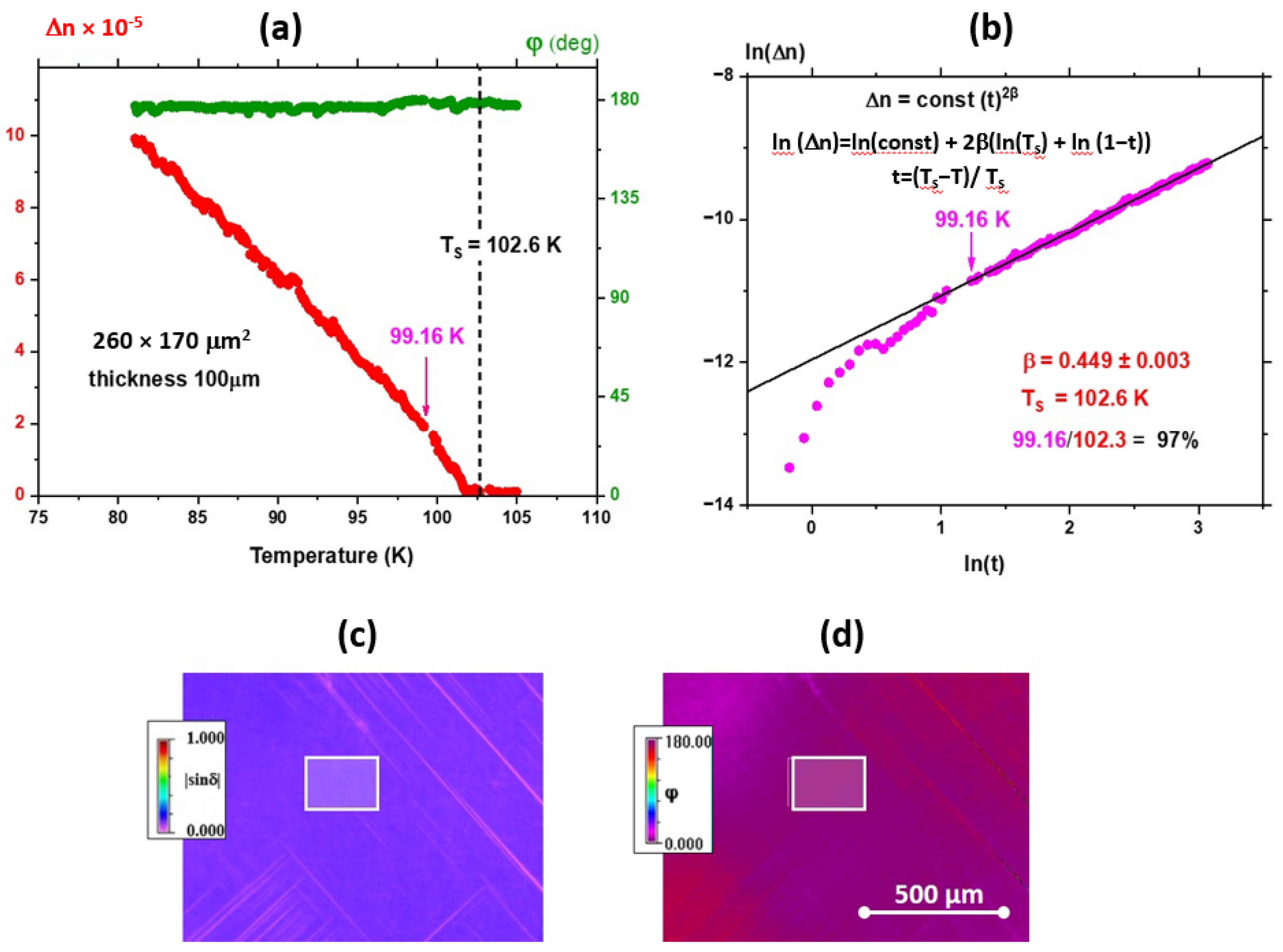


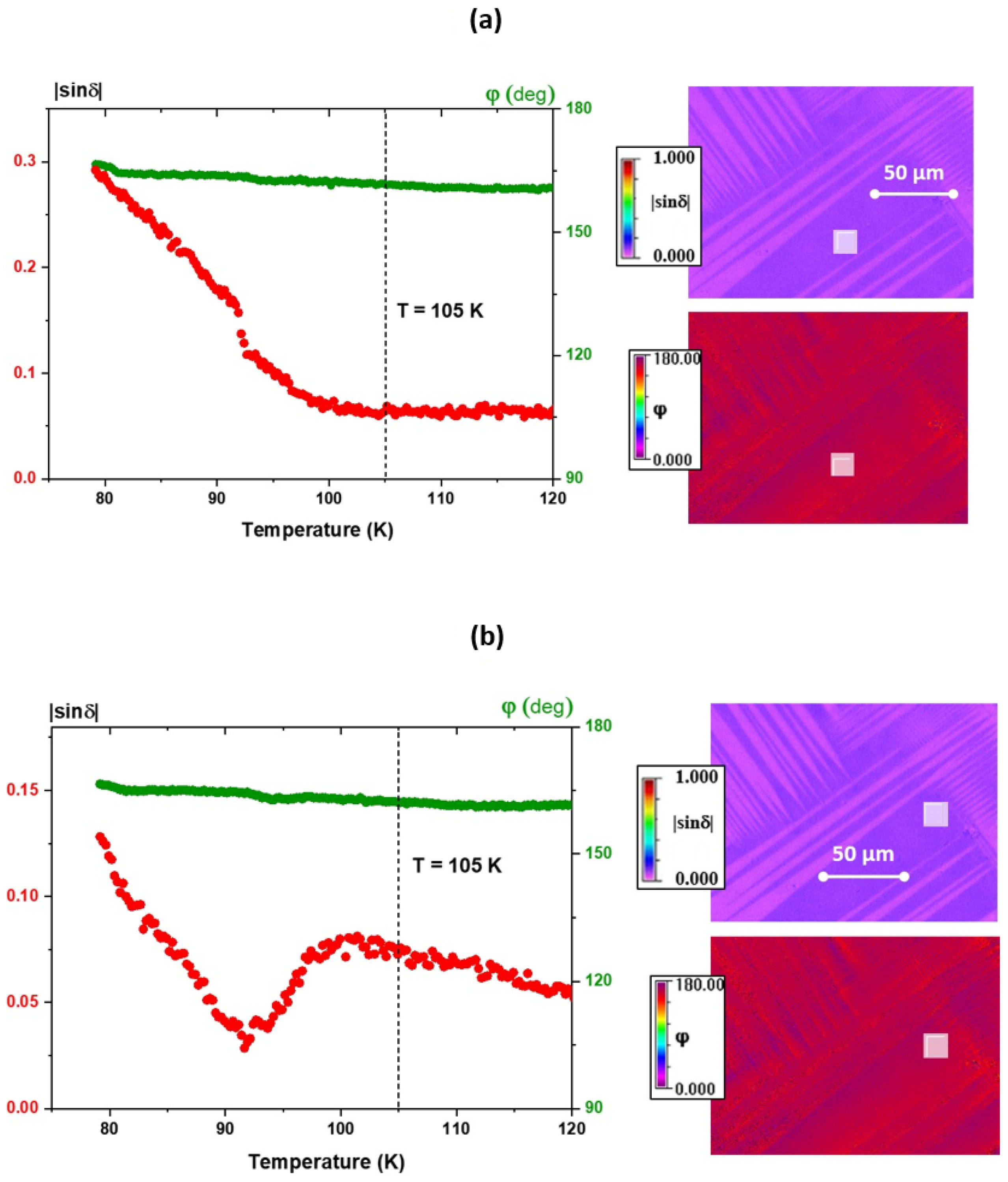
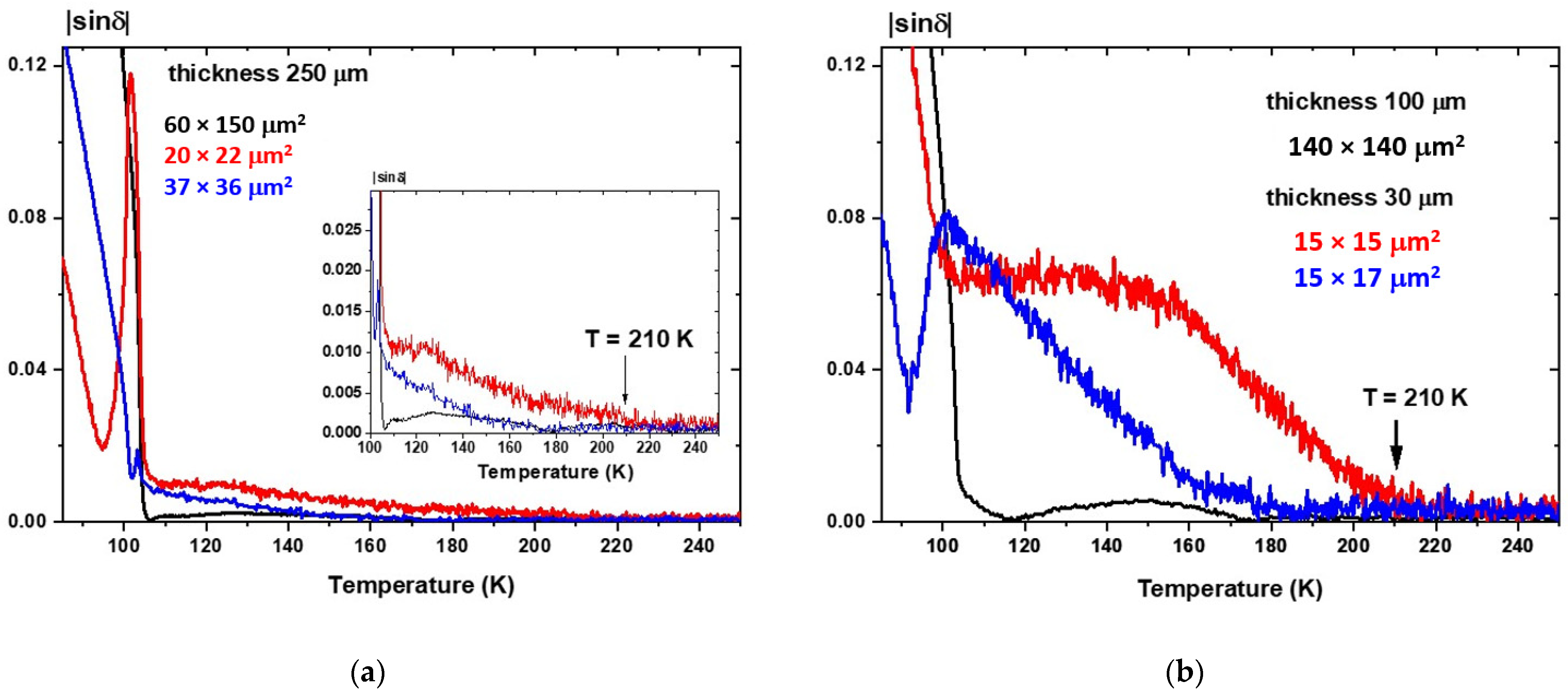

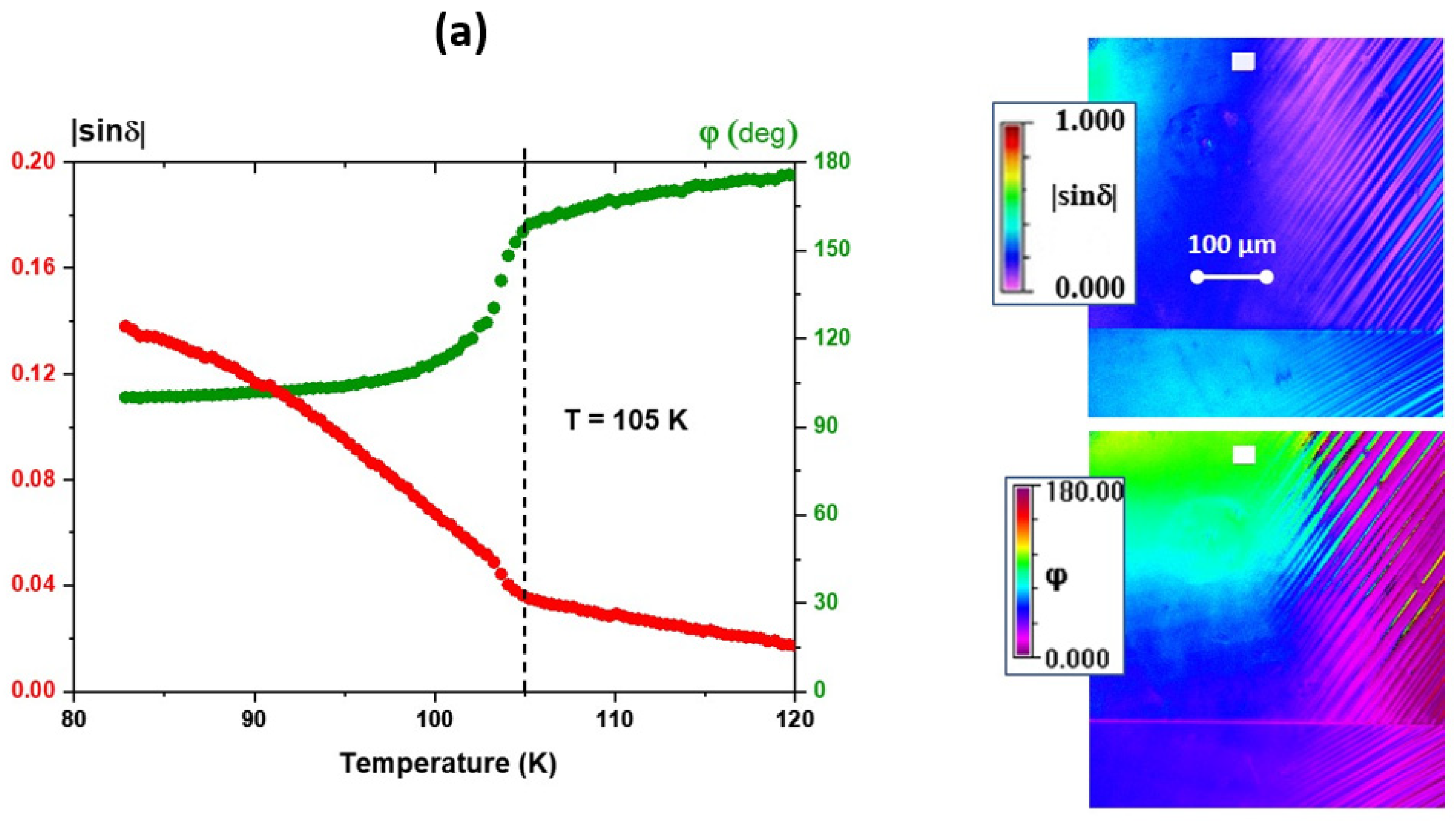
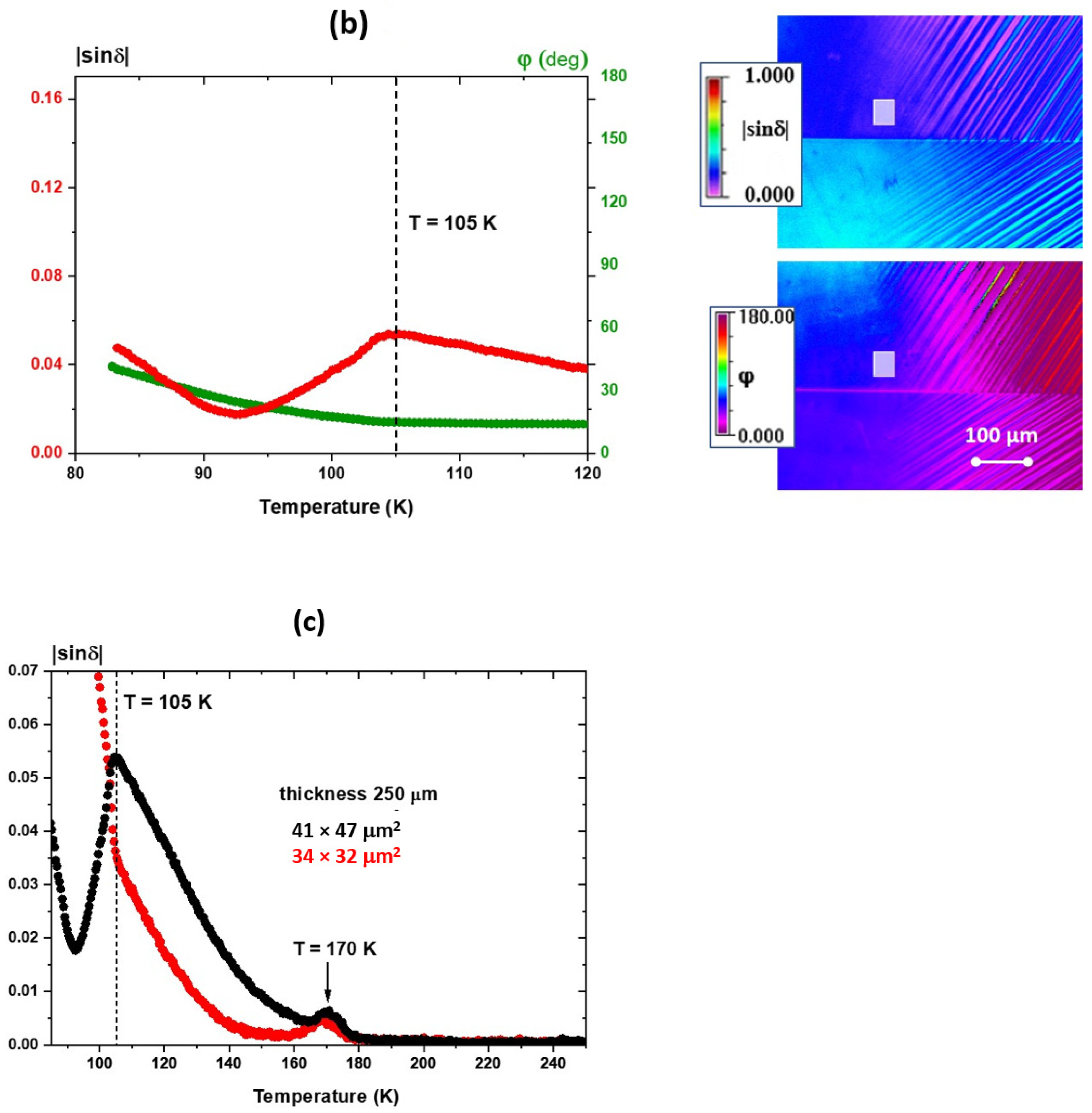
| Thickness of STO Crystal | Ts | Type of Transition | Birefringence Disappearance/Value |
|---|---|---|---|
| 30 µm | Difficult to determine | Difficult to determine | 210 K/strong |
| 100 µm | 102.6 K | Close to second-order transition | 210 K/very weak |
| 250 µm | Close to 105 K | Difficult to determine | 210 K/ average |
| 24 bi-crystal 250 µm | Close to 105 K | Difficult to determine | 180 K/strong, with a peak at 170 K |
Disclaimer/Publisher’s Note: The statements, opinions and data contained in all publications are solely those of the individual author(s) and contributor(s) and not of MDPI and/or the editor(s). MDPI and/or the editor(s) disclaim responsibility for any injury to people or property resulting from any ideas, methods, instructions or products referred to in the content. |
© 2023 by the authors. Licensee MDPI, Basel, Switzerland. This article is an open access article distributed under the terms and conditions of the Creative Commons Attribution (CC BY) license (https://creativecommons.org/licenses/by/4.0/).
Share and Cite
Lazar, I.; Szot, K.; Roleder, K. Influence of Defects-Induced Stresses on Birefringence in SrTiO3 Single Crystals. Crystals 2023, 13, 985. https://doi.org/10.3390/cryst13070985
Lazar I, Szot K, Roleder K. Influence of Defects-Induced Stresses on Birefringence in SrTiO3 Single Crystals. Crystals. 2023; 13(7):985. https://doi.org/10.3390/cryst13070985
Chicago/Turabian StyleLazar, Iwona, Krzysztof Szot, and Krystian Roleder. 2023. "Influence of Defects-Induced Stresses on Birefringence in SrTiO3 Single Crystals" Crystals 13, no. 7: 985. https://doi.org/10.3390/cryst13070985
APA StyleLazar, I., Szot, K., & Roleder, K. (2023). Influence of Defects-Induced Stresses on Birefringence in SrTiO3 Single Crystals. Crystals, 13(7), 985. https://doi.org/10.3390/cryst13070985






